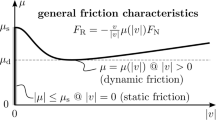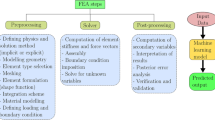Abstract
We present an object-oriented framework, named DOOLINES , for non-linear static and dynamic analyses of slender marine structures which often appear in offshore structures employed in the petroleum and gas industries as, among others, flexible risers, steel catenary risers, umbilicals, floating hoses, and mooring lines. DOOLINES allows the rapid development of tailored, modular, reusable and extensible large-size systems, being itself extensible. These properties, along with the ease of use of our framework, are assessed by means of case studies. Code examples are provided.







Similar content being viewed by others
Notes
References
Almeida G, Ferreira FMG, Santos A, Teichrieb V, Kelner J, Silveira ESS (2008) Sistema de Visualização Científica em Tempo Real para Aplicações de Engenharia. In: Proceedings of XXIX Iberian Latin-American Congress on Computational Methods in Engineering (XXIX CILAMCE), CD-ROM
Archer GC, Fenves G, Thewalt C (1999) A new object-oriented finite element analysis program architecture. Comput Struct 70(1):63–75. doi:10.1016/S0045-7949(98)00194-1
Ariane-3dynamic (2011) http://www.mcskenny.com/mcskenny/software-solutions/ariane-3dynamic.htm. Accessed May 2011
Bathe KJ (1995) Finite element procedures (part 1–2), 2nd edn. Prentice Hall, Englewood Cliffs
Beall MW, Shephard MS (1999) An object-oriented framework for reliable numerical simulations. Eng Comput 15(1):61–72. doi:10.1007/s003660050005
Cardona A, Klapka I, Geradin M (1993) Design of a new finite element programming environment. Eng Comput 11(4):365–381
Chen HM, Archer GC (2001) A distributed object-oriented finite-element analysis program architecture. Comput Aided Civil Infrastruct Eng 16(5):326–336
Chung JT, Lee JM (1994) A new family of explicit time integration methods for linear and nonlinear structural dynamics. Int J Numer Methods Eng 37(23):3961–3976
Deeplines (2011) http://www.principia.fr/expertise-fields-software-products-deeplines-126.htm. Accessed May 2011
Delalondre F, Smith C, Shephard MS (2010) Collaborative software infrastructure for adaptive multiple model simulation. Comput Methods Appl Mech Eng 199(21–22):1352–1370. doi:10.1016/j.cma.2010.01.011
Duboispelerin Y, Zimmermann T (1993) Object-oriented finite-element programming 3: an efficient implementation in C++. Comput Methods Appl Mech Eng 108(1–2):165–183
Duboispelerin Y, Zimmermann T, Bomme P (1992) Object-oriented finite-element programming 2: a prototype program in Smalltalk. Comput Methods Appl Mech Eng 98(3):361–397
Eclipse (2011) http://www.eclipse.org. Accessed May 2011
Fenves GL (1990) Object-oriented programming for engineering software-development. Eng Comput 6(1):1–15
Fernandes AC, Rossi RR, Castro GAV (1999) Third order model for the polyester mooring cables dynamics. In: Proceedings of the 9th international offshore and polar engineering conference, pp 364–368. International Society of Offshore and Polar Engineers
Flexcom (2011) http://www.mcskenny.com/mcskenny/software-solutions/flexcom.html. Accessed May 2011
Ghadimi R (1988) A simple and efficient algorithm for the static and dynamic analysis of flexible marine risers. Comput Struct 29(4):541–555
Hsieh SH, Modak S, Sotelino ED (1995) Object-oriented parallel programming tools for structural engineering applications. Comput Syst Eng 6(6):533–548
Hsieh SH, Sotelino ED (1997) A message-passing class library C++ for portable parallel programming. Eng Comput 13(1):20–34
Hulbert GM, Chung JT (1996) Explicit time integration algorithms for structural dynamics with optimal numerical dissipation. Comput Methods Appl Mech Eng 137(2):175–188
Jiao XM, Zheng GB, Alexander PA, Campbell MT, Lawlor OS, Norris J, Haselbacher A, Heath MT (2006) A system integration framework for coupled multiphysics simulations. Eng Comput 22(3–4):293–309. doi:10.1007/s00366-006-0034-x
Lu J, White DW, Chen WF, Dunsmore HE (1995) A matrix class library in C++ for structural-engineering computing. Comput Struct 55(1):95–111
Mackie RI (1992) Object oriented programming of the finite-element method. Int J Numer Methods Eng 35(2):425–436. doi:10.1002/nme.1620350212
Masetti IQ, Rolo LF, Silveira ESS, Carvalho MTM, Menezes IFM (1997) Sistemas Computacionais para Análises Estática e Dinâmica de Linhas de Ancoragem. In: Proceedings of XVIII Iberian Latin-American Congress on Computational Methods in Engineering (XVIII CILAMCE), pp 1901–1908
Menetrey P, Zimmermann T (1993) Object-oriented nonlinear finite-element analysis: application to J2 plasticity. Comput Struct 49(5):767–777
Miller GR (1991) An object-oriented approach to structural-analysis and design. Comput Struct 40(1):75–82. doi:10.1016/0045-7949(91)90459-Y
Mimosa (2011) http://www.sintef.no/home/MARINTEK/Software-developed-at-MARINTEK/MIMOSA. Accessed May 2011
Morison JR, O’Brien MP, Johnson JW, Schaaf S (1950) The force exerted by surface wave on piles. Trans Am Inst Min Metall Eng 189:147–154
Mukunda GR, Sotelino ED, Hsieh SH (1998) Distributed finite element computations using object-oriented techniques. Eng Comput 14:59–72. doi:10.1007/BF01198975
Newmark NM (1959) A method of computation for structural dynamics. ASCE J Eng Mech Div 85:67–94
Nishimoto K, Ferreira MD, Masetti IQ, Silveira ESS, Menezes IFM, Russo A, Fucatu CH, Tanuri E (2004) Sistema de Visualização Científica em Tempo Real para Aplicações de Engenharia. In: Proceedings of XXV Iberian Latin-American Congress on Computational Methods in Engineering (XXV CILAMCE), CD-ROM
Nishimoto K, Fucatu CH, Masetti IQ (2002) Dynasim: a time domain simulator of anchored FPSO. J Offshore Mech Artic Eng Trans ASME 124(4):203–211. doi:10.1115/1.1513176
Orcaflex (2011) http://www.orcina.com. Accessed May 2011
Otter JRH, Cassell AC, Hobbs RE (1966) Dynamic relaxation. In: Proceedings of the Institution of Civil Engineers, vol 35, pp 633–656. doi:10.1680/iicep.1966.8604
Pacoste C, Eriksson A (1997) Beam elements in instability problems. Comput Methods Appl Mech Eng 144(1–2):163–197
Pidaparti RMV, Hudli AV (1993) Dynamic analysis of structures using object-oriented techniques. Comput Struct 49(1):149–156
Raphael B, Krishnamoorthy CS (1992) Automating finite element development using object oriented techniques. Eng Comput 267–278. doi:10.1108/eb023907
Riflex (2011) http://www.sintef.no/home/MARINTEK/Software-developed-at-MARINTEK/RIFLEX. Accessed May 2011
Sahu R, Panthaki MJ, Gerstle WH (1999) An object-oriented framework for multidisciplinary, multi-physics, computational mechanics. Eng Comput 15:105–125. doi:10.1007/s003660050008
Schmidt DC (1997) Applying design patterns and frameworks to develop object-oriented communication software, vol 1, 2nd edn. Macmillan, Indianapolis
Schmidt DC (2011) The adaptive communication environment framework. http://www.cs.wustl.edu/schmidt/ACE.htm. Accessed May 2011
Scholz SP (1992) Elements of an object-oriented FEM++ program in C++. Comput Struct 43(3):517–529
Shames IH, Cozzarelli FA (1997) Elastic and inelastic stress analysis, vol 1, 2nd edn. Taylor & Francis, Washington, DC
SUBVERSION (2011) Subversion is an open source version control system. http://subversion.apache.org. Accessed May 2011
Unified Modeling Language (UML) (2011) http://www.uml.org. Accessed May 2011
White S, O’Madadhain J, Fisher D, Boey Y (2011) JUNG: Java Universal Network/Graph Framework. http://jung.sourceforge.net. Accessed May 2011
Yu LC, Kumar AV (2001) An object-oriented modular framework for implmenting the finite element method. Comput Struct 79(9):919–928
Zeglinski GW, Han RPS, Aitchison P (1994) Object-oriented matrix classes for use in a finite-element code using C++. Int J Numer Methods Eng 37(22):3921–3937
Zimmermann T, Duboispelerin Y, Bomme P (1992) Object-oriented finite-element programming 1: governing principles. Comput Methods Appl Mech Eng 98(2):291–303
Acknowledgment
CAPES provided partial support for this work.
Author information
Authors and Affiliations
Corresponding author
Rights and permissions
About this article
Cite this article
da Silveira, E.S.S., Lages, E.N. & Ferreira, F.M.G. DOOLINES : an object-oriented framework for non-linear static and dynamic analyses of offshore lines. Engineering with Computers 28, 149–159 (2012). https://doi.org/10.1007/s00366-011-0226-x
Received:
Accepted:
Published:
Issue Date:
DOI: https://doi.org/10.1007/s00366-011-0226-x




